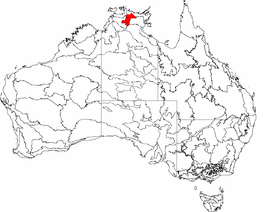Arnhem Plateau
| Arnhem Plateau Northern Territory | |||||||||||||
|---|---|---|---|---|---|---|---|---|---|---|---|---|---|
|
[[File:[Ptilinopus cinctus albocinctus by Joseph Wolf.jpg|frameless|upright=1.23]] The area is an important site for banded fruit doves | |||||||||||||
 | |||||||||||||
| Area | 23,060 km2 (8,903.5 sq mi) | ||||||||||||
| |||||||||||||
The Arnhem Plateau, an interim Australian bioregion, is located in the Northern Territory,[1][2] comprising an area of 2,306,023 hectares (5,698,310 acres)[3] of the raised and heavily dissected sandstone plateau that characterises central Arnhem Land in the Top End of the Northern Territory.[4]
Description
The boundary of the 22,000-square-kilometre (8,500 sq mi) Important Bird Area (IBA) is largely defined by the extent of vegetation suitable for white-throated grasswrens. The most important habitat for grasswrens is bare rock and spinifex grassland. Other vegetation includes open monsoonal savanna woodland and patches of rainforest, especially that dominated by the endemic tree Allosyncarpia ternata. About a quarter of the IBA is within Kakadu National Park; a southern outlier is in Nitmiluk National Park, with much of the remainder due to be incorporated in the Wardekken Indigenous Protected Area.[5]
Birds
Identified as an important bird area by BirdLife International, the plateau supports the entire population of white-throated grasswrens, and most of the populations of white-lined honeyeaters, chestnut-quilled rock-pigeons and the local subspecies of black-banded fruit doves and helmeted friarbirds. It also supports populations of bush stone-curlews, varied lorikeets, northern rosellas, rainbow pittas, white-gaped, yellow-tinted, bar-breasted and banded honeyeaters, silver-crowned friarbirds, masked and long-tailed finches, and sandstone shrike-thrushes.[6]
See also
References
- ↑ Environment Australia. "Revision of the Interim Biogeographic Regionalisation for Australia (IBRA) and Development of Version 5.1 - Summary Report". Department of the Environment and Water Resources, Australian Government. Archived from the original on 2006-09-05. Retrieved 2007-01-31.
- ↑ IBRA Version 6.1 data
- ↑ "Interim Biogeographic Regionalisation for Australia (IBRA7) regions and codes". Department of Sustainability, Environment, Water, Population and Communities. Commonwealth of Australia. 2012. Retrieved 13 January 2013.
- ↑ "Arnhem Plateau bioregion" (PDF). Arnhem Plateau bioregion. NT Environment Department. Retrieved 1 May 2015.
- ↑ BirdLife International. (2011). Important Bird Areas factsheet: Arnhem Plateau. Downloaded from "Archived copy". Archived from the original on 2007-07-10. Retrieved 2014-03-07. on 2011-12-08.
- ↑ "IBA: Arnhem Plateau". Birdata. Birds Australia. Retrieved 2011-12-08.
Coordinates: 13°11′28″S 133°10′50″E / 13.19111°S 133.18056°E